Richard Caton Woodville, Jr.
| Richard Caton Woodville | |
|---|---|
 | |
| Born |
7 January 1856 London |
| Died |
17 August 1927 (aged 71) London |
| Nationality | British |
| Education | Düsseldorf school of painting |
| Known for | portrait, landscape, illustration, battle painting |
| Patron(s) | Illustrated London News |

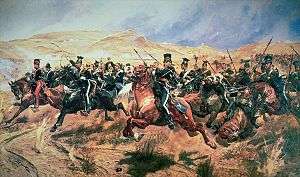
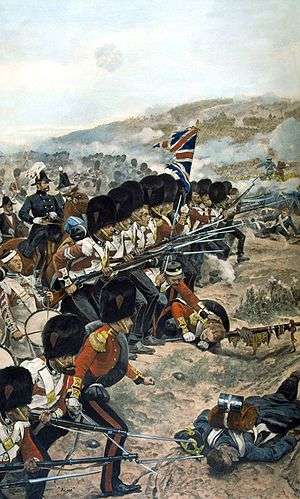
Richard Caton Woodville (7 January 1856 – 17 August 1927) was an English artist and illustrator, who is best known for being one of the most prolific and effective painters of battle scenes in the late 19th and early 20th centuries.
Biography
The son of Richard Caton Woodville, Sr., who was also a talented artist, Woodville studied at the Düsseldorf school of painting under the Prussian military artist Wilhelm Camphausen, and then Eduard von Gebhardt, before briefly studying in Russia and then Paris under Jean-Léon Gérôme. Woodville spent most of his career working for the Illustrated London News, where he quickly developed a reputation as a talented reporter and writer, but was also published in Cornhill Magazine, Strand Magazine, and The Tatler.
Richard Caton Woodville first experienced battle first-hand when he was sent by the Illustrated London News to report upon the Russo-Turkish War (1877–1878), and then again in the 1882 Anglo-Egyptian War, where he made numerous sketches in December 1882, and also obtained photographs of the trenches at Tel-e-Kebir for his friend and co-artist Alphonse-Marie-Adolphe de Neuville, who had been commissioned to paint a scene of the battle.
In 1879, Woodville's Before Leuthen, 3 Dec 1757 was exhibited in the Royal Academy. It proved popular, and afterwards he began to regularly be exhibited in Burlington House, where 21 of his battle paintings were eventually shown. His most popular works there were ones that dealt with contemporary wars, such as the Second Anglo-Afghan War, Candahar [sic], and Maiwand: Saving the Guns, (Walker Art Gallery), the Zulu War, and the First Boer War. His works from Egypt were exhibited at the Fine Art Society in 1883, where his painting The Moonlight Charge at Kassassin proved very popular. The following year he exhibited by Royal Command another painting he had done of the war in Egypt, entitled The Guards at Tel-e-Kebir (Royal Collection).
He continued to paint scenes of battle, and few battles or wars that Great Britain fought during his life were not touched upon by him, including the Second Boer War, and World War I. Despite his precocious talent for capturing the dramatic moments of contemporary battles, Woodville also enjoyed recreating historical scenes in both oil and watercolour. The Illustrated London News commissioned him to complete a commemorative special series recreating the most famous British battles of history. He depicted The Charge of the Light Brigade (Palacio Real de Madrid) and The Charge of the 21st Lancers at Omdurman (Walker Art Gallery), Battle of Blenheim, Battle of Badajos and several Battle of Waterloo pictures.
During World War I, Woodville was compelled to return to the depiction of current events, and three of his Great War works were displayed in the Royal Academy. These were The 2nd Batt. Manchester Regiment taking six guns at dawn near St. Quentin, Entry of the 5th Lancers into Mons, and Halloween, 1914: Stand of the London Scottish on Messines Ridge (London Scottish Regiment Museum Trust) exhibited in the year of his death, 1927.
During his lifetime, Woodville enjoyed great popularity and was probably considered the best artist of his genre. He wrote as well as painted, and was often the subject of magazine and journal articles. He had a deep passion for the British Army and had even joined the Berkshire Yeomanry in 1879, staying with them until 1914 when he joined the National Reserve as a Captain.
On 17 August 1927, Woodville was found shot at his studio at St John's Wood; a revolver was also found.[1] An inquest determined that he was of unsound mind when he committed suicide.[1]
Richard Caton Woodville is still exhibited in the National Army Museum, the Tate, Walker Art Gallery, and the Royal Academy.
Caton Woodville died effectively destitute and his grave (No 10112 in the old section of St Mary's Catholic Cemetery in Harrow Road adjacent to Kensal Green cemetery), was not marked at the time of his death.
In September 2013 a headstone, commissioned by his great-grandson, was placed on the grave.[2]
Paintings (by date)
- Before Leuthen, 3 Dec 1757 (1879 - Private Collection)
- Turkish Reconnoitring Party in Balkans (Russo-Turkish War) (1878 - Private Collection)
- Candahar: The 92nd Highlanders & 2nd Goorkhas storming Gaudi Mullah Sahabdad, (1881 - Private Collection)
- Cruel To Be Kind, (1882 - National Army Museum)
- The Moonlight Charge at Kassassin (1883)
- Maiwand: Saving the Guns (1883 - Walker Art Gallery)
- In the Nick of Time, (1883 - Private Collection)
- The Guards at Tel-e-Kebir (1885 - Royal Collection)
- The Late Commander Wyatt-Rawson, R.N., killed at Tel-el-Kebir, 13 September 1882, (1885 - Royal Naval College, Greenwich)
- The Charge of the Light Brigade (1894 - Palacio Real de Madrid)
- Waterloo: The Old Guard, (Palacio Real de Madrid)
- The Storming of the Great Redoubt at the Battle of the Alma, (1896 - Coldstream Guards)
- The Relief of the Light Brigade, (1897 - National Army Museum)
- A Gentleman in Khaki, (1899, to promote the charitable efforts of The Absent-Minded Beggar)
- Life Guards charging at the Battle of Waterloo, (1899 - Private Collection)
- Gordon's Memorial Service at His Ruined Palace in Khartoum, the Day after The Battle of Omdurman, (1899 - Royal Collection)
- The Dawn of Majuba, (1900 - The Royal Canadian Regiment Museum, London, Ontario)
- French Hussards fording a River, (1901 - Private Collection)
- Lindlay: Whitsunday, 1900 (Church service on the veldt), (1901 - 5th Battalion, Royal Green Jackets, Oxford)
- All that was left of them, (1902 - 17th/21st Lancers Museum, Belvoir Castle)
- Scotland Yet! On to Victory (Scots Greys at Waterloo), (1904 - Royal Scots Dragoon Guards)
- At the Trumpet's Call (Marston Moor), (1904 - Private Collection)
- General Wolfe Climbing the Heights of Abraham on the Morning of the Battle of Quebec, (1906 - Tate)
- The Returning Orderly, (1908 - Williamson Art Gallery, Birkenhead)
- Napoleon before Wagram, (1909 - Private Collection)
- Sic Transit Gloria Mundi (Retreat from Moscow), (1911 - Private Collection)
- Napoleon Crossing the Bridge to Lobau Island, (1912 - Tate)
- Poniatowski's Last Charge at Leipzig, (1912 - Tate)
- Napoleon confering the Legion D'Honneur on a Russian General, 1804, (1912 - Private Collection)
- Drawn Sabres: Napoleon's Guards at the Battle of Wagram, West Point
- A Narrow Shave! Dragoon in Napoleon's Army 1810 (Private Collection)
- Marshal Ney at Eylau, (1913 - Tate)
- The First VC of the European War, (1914 - National Army Museum)
- The Last Call (Trumpeter falling at Charge of Light Brigade), (1915 - The Queen's Royal Hussars)
- The Piper of Loos, (King's Own Scottish Borderers Regimental Association)
- The Battle of the Somme, (1917 - Guards Museum
- The 2nd Batt. Manchester Regiment taking six guns at dawn near St. Quentin, (1918 - Duke of Lancaster's Regiment)
- Entry of the 5th Lancers into Mons, (1919 - Queen's Royal Lancers)
- The Charge of the 9th Lancers at Moncel, 7 September 1914, (1921 - 9th Queen's Royal Lancers)
- Halloween, 1914: Stand of the London Scottish on Messines Ridge (1927 - London Scottish Regiment Museum Trust)
Paintings (non-military)
- Ascending The Great Pyramid
- Tyrol - Turning The Great Corner
- Burma - Minister of State With Attendants
- Bull-Fighting
- Trades - Estate Agent 'Sold'
- Fishing For Bass On The South Coast of England
- London - Hyde Park In The Row
- Lost Their Way
Gallery
 "The Devil's Own" 88th Regiment at the Siege of Badajoz"
"The Devil's Own" 88th Regiment at the Siege of Badajoz"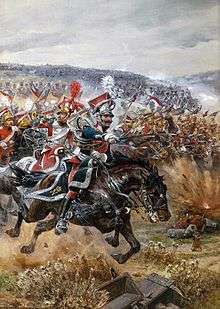 "Poniatowski's Last Charge at Leipzig"
"Poniatowski's Last Charge at Leipzig" "Candahar: The 92nd Highlanders & 2nd Goorkhas storming Gaudi Mullah Sahabdad"
"Candahar: The 92nd Highlanders & 2nd Goorkhas storming Gaudi Mullah Sahabdad" "The Battle of Majuba" drawn for the Illustrated London News
"The Battle of Majuba" drawn for the Illustrated London News.jpg) "All That Was Left of Them"
"All That Was Left of Them" "The 2nd Batt. Manchester Regiment taking six guns at dawn near St. Quentin"
"The 2nd Batt. Manchester Regiment taking six guns at dawn near St. Quentin"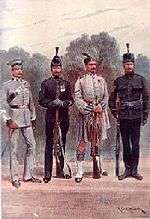 "Battalions of the London Regiment"
"Battalions of the London Regiment" "Lord Roberts of Kabul and Kandahar on his Celebrated Charger"
"Lord Roberts of Kabul and Kandahar on his Celebrated Charger" "Charge of the 5th Lancers at Elandslaagte"
"Charge of the 5th Lancers at Elandslaagte" "The defeat of Lord Methuen's force by De la Rey at Tweebosch, 7 March 1902"
"The defeat of Lord Methuen's force by De la Rey at Tweebosch, 7 March 1902"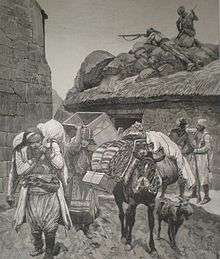 Turkish refugees from Eastern Rumelia in 1885 drawn for The Illustrated London News
Turkish refugees from Eastern Rumelia in 1885 drawn for The Illustrated London News
References
Further reading
- Compton, Roy (January 1897). "A Chat with Caton Woodville". Idler. X (VI): 758–775.
- Harrington, Peter (1993). British Artists and War: The Face of Battle in Paintings and Prints, 1700-1914. London: Greenhill.
- Mayhew, Athol (July–Dec 1884). "Battle Painters of the XIXth Century. 1. Richard Caton Woodville". Illustrated Naval and Military Magazine. I: 50–54. Check date values in:
|date=(help) - T.H.L. (7 December 1895). "R. Caton Woodville". Illustrated London News: 1–3.
- Warren, Arthur (July 1906). R. Caton Woodville, Artist and War Correspondent. Captain. XV. pp. 290–299.
- Woodville, Richard Caton. (1914) London: Eveleigh Nash.
External links
External links
- Roger T. Stearn, ‘Woodville, Richard Caton (1856–1927)’, Oxford Dictionary of National Biography, Oxford University Press, 2004, accessed 2 Jan 2008
- Works by or about Richard Caton Woodville, Jr. in libraries (WorldCat catalog)
- Anne S. K. Brown Military Collection, Brown University Library Prints, drawings and water-colours
| Wikimedia Commons has media related to Richard Caton Woodville, Jr.. |